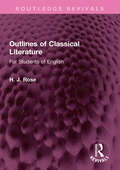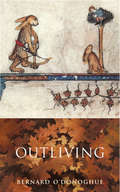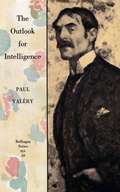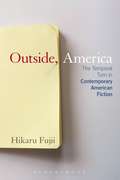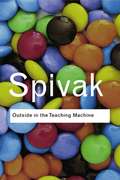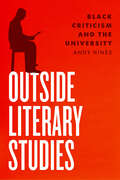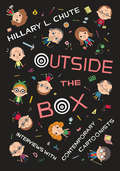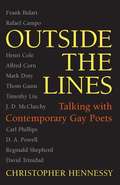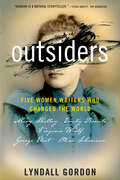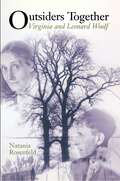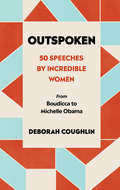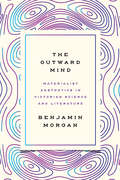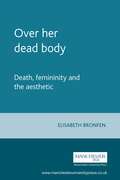- Table View
- List View
Outlines of Classical Literature: For Students of English (Routledge Revivals)
by H. J. RoseFirst published in 1959, Outlines of Classical Literature is a guide for students of English literature who too often come to this difficult and complex subject with little or no knowledge of one of its principal sources. It therefore does not attempt to give a complete account of the Greek and Roman writers, but tries instead to deal with those whose influences, direct or indirect, can be clearly traced in medieval and later authors. The ancients are taken in their chronological order, though this is not necessarily the order in which they became known to, or influenced the Christian World; but to follow the latter would be too confusing. The book should be of interest to the undergraduate, the general reader and to the literary critic desirous of displaying classical erudition.
Outliving
by Bernard O'DonoghueBernard O'Donoghue's magnificent fourth collection of poetry explores its title in a series of beautifully wrought poems whose simple elegance belie their complexity. There are moving elegies for people the poet has outlived. There are poems too about living outside the poet's original environment and the inclination to return there for stories and feelings: the MacNeicean 'tourist in his own country', perpetually restive and homesick. Ireland for O'Donoghue is both more real than anywhere else and strangely ghostly - a country where the past is preserved but also where a rural generation is dying out. A place, a moment, a person - each poem reaches out from the particular to a luminous understanding of the uncertainties of life.
The Outlook for Intelligence: (With a preface by Francois Valery)
by Paul Valéry Denise Folliot Jackson MathewsThe description for this book, The Outlook for Intelligence: (With a preface by Francois Valery), will be forthcoming.
Outside, America: The Temporal Turn in Contemporary American Fiction
by Hikaru FujiiThe idea of the "outside" as a space of freedom has always been central in the literature of the United States. This concept still remains active in contemporary American fiction; however, its function is being significantly changed. Outside, America argues that, among contemporary American novelists, a shift of focus to the temporal dimension is taking place. No longer a spatial movement, the quest for the outside now seeks to reach the idea of time as a force of difference, a la Deleuze, by which the current subjectivity is transformed. In other words, the concept is taking a "temporal turn." Â Discussing eight novelists, including Don DeLillo, Richard Powers, Paul Theroux, and Annie Proulx, each of whose works describe forces of given identities-masculine identity, historical temporality, and power, etc.-which block quests for the outside, Fujii shows how the outside in these texts ceases to be a spatial idea. With due attention to critical and social contexts, the book aims to reveal a profound shift in contemporary American fiction.
Outside, America: The Temporal Turn in Contemporary American Fiction
by Hikaru FujiiThe idea of the "outside" as a space of freedom has always been central in the literature of the United States. This concept still remains active in contemporary American fiction; however, its function is being significantly changed. Outside, America argues that, among contemporary American novelists, a shift of focus to the temporal dimension is taking place. No longer a spatial movement, the quest for the outside now seeks to reach the idea of time as a force of difference, a la Deleuze, by which the current subjectivity is transformed. In other words, the concept is taking a "temporal turn." Discussing eight novelists, including Don DeLillo, Richard Powers, Paul Theroux, and Annie Proulx, each of whose works describe forces of given identities-masculine identity, historical temporality, and power, etc.-which block quests for the outside, Fujii shows how the outside in these texts ceases to be a spatial idea. With due attention to critical and social contexts, the book aims to reveal a profound shift in contemporary American fiction.
Outside in the Teaching Machine
by Gayatri Chakravorty SpivakGayatri Chakravorty Spivak is one of the most pre-eminent postcolonial theorists writing today and a scholar of genuinely global reputation. This collection, first published in 1993, presents some of Spivak’s most engaging essays on works of literature such as Salman Rushdie's controversial Satanic Verses, and twentieth century thinkers such as Jacques Derrida and Karl Marx. Spivak relentlessly questions and deconstructs power structures where ever they operate. In doing so, she provides a voice for those who can not speak, proving that the true work of resistance takes place in the margins, Outside in the Teaching Machine.
Outside in the Teaching Machine
by Gayatri Chakravorty SpivakGayatri Chakravorty Spivak is one of the most pre-eminent postcolonial theorists writing today and a scholar of genuinely global reputation. This collection, first published in 1993, presents some of Spivak’s most engaging essays on works of literature such as Salman Rushdie's controversial Satanic Verses, and twentieth century thinkers such as Jacques Derrida and Karl Marx. Spivak relentlessly questions and deconstructs power structures where ever they operate. In doing so, she provides a voice for those who can not speak, proving that the true work of resistance takes place in the margins, Outside in the Teaching Machine.
Outside Literary Studies: Black Criticism and the University
by Andy HinesA timely reconsideration of the history of the profession, Outside Literary Studies investigates how midcentury Black writers built a critical practice tuned to the struggle against racism and colonialism. This striking contribution to Black literary studies examines the practices of Black writers in the mid-twentieth century to revise our understanding of the institutionalization of literary studies in America. Andy Hines uncovers a vibrant history of interpretive resistance to university-based New Criticism by Black writers of the American left. These include well-known figures such as Langston Hughes and Lorraine Hansberry as well as still underappreciated writers like Melvin B. Tolson and Doxey Wilkerson. In their critical practice, these and other Black writers levied their critique from “outside” venues: behind the closed doors of the Senate Permanent Subcommittee on Investigations, in the classroom at a communist labor school under FBI surveillance, and in a host of journals. From these vantages, Black writers not only called out the racist assumptions of the New Criticism, but also defined Black literary and interpretive practices to support communist and other radical world-making efforts in the mid-twentieth century. Hines’s book thus offers a number of urgent contributions to literary studies: it spotlights a canon of Black literary texts that belong to an important era of anti-racist struggle, and it fills in the pre-history of the rise of Black studies and of ongoing Black dissent against the neoliberal university.
Outside the Box: Interviews with Contemporary Cartoonists
by Hillary L. ChuteWe are living in a golden age of cartoon art. Never before has graphic storytelling been so prominent or garnered such respect: critics and readers alike agree that contemporary cartoonists are creating some of the most innovative and exciting work in all the arts. For nearly a decade Hillary L. Chute has been sitting down for extensive interviews with the leading figures in comics, and with Outside the Box she offers fans a chance to share her ringside seat. Chute’s in-depth discussions with twelve of the most prominent and accomplished artists and writers in comics today reveal a creative community that is richly interconnected yet fiercely independent, its members sharing many interests and approaches while working with wildly different styles and themes. Chute’s subjects run the gamut of contemporary comics practice, from underground pioneers like Art Spiegelman and Lynda Barry, to the analytic work of Scott McCloud, the journalism of Joe Sacco, and the extended narratives of Alison Bechdel, Charles Burns, and more. They reflect on their experience and innovations, the influence of peers and mentors, the reception of their art and the growth of critical attention, and the crucial place of print amid the encroachment of the digital age. Beautifully illustrated in full-color, and featuring three never-before-published interviews—including the first published conversation between Art Spiegelman and Chris Ware—Outside the Box will be a landmark volume, a close-up account of the rise of graphic storytelling and a testament to its vibrant creativity.
Outside the Box: Interviews with Contemporary Cartoonists
by Hillary L. ChuteWe are living in a golden age of cartoon art. Never before has graphic storytelling been so prominent or garnered such respect: critics and readers alike agree that contemporary cartoonists are creating some of the most innovative and exciting work in all the arts. For nearly a decade Hillary L. Chute has been sitting down for extensive interviews with the leading figures in comics, and with Outside the Box she offers fans a chance to share her ringside seat. Chute’s in-depth discussions with twelve of the most prominent and accomplished artists and writers in comics today reveal a creative community that is richly interconnected yet fiercely independent, its members sharing many interests and approaches while working with wildly different styles and themes. Chute’s subjects run the gamut of contemporary comics practice, from underground pioneers like Art Spiegelman and Lynda Barry, to the analytic work of Scott McCloud, the journalism of Joe Sacco, and the extended narratives of Alison Bechdel, Charles Burns, and more. They reflect on their experience and innovations, the influence of peers and mentors, the reception of their art and the growth of critical attention, and the crucial place of print amid the encroachment of the digital age. Beautifully illustrated in full-color, and featuring three never-before-published interviews—including the first published conversation between Art Spiegelman and Chris Ware—Outside the Box will be a landmark volume, a close-up account of the rise of graphic storytelling and a testament to its vibrant creativity.
Outside the Box: Interviews with Contemporary Cartoonists
by Hillary L. ChuteWe are living in a golden age of cartoon art. Never before has graphic storytelling been so prominent or garnered such respect: critics and readers alike agree that contemporary cartoonists are creating some of the most innovative and exciting work in all the arts. For nearly a decade Hillary L. Chute has been sitting down for extensive interviews with the leading figures in comics, and with Outside the Box she offers fans a chance to share her ringside seat. Chute’s in-depth discussions with twelve of the most prominent and accomplished artists and writers in comics today reveal a creative community that is richly interconnected yet fiercely independent, its members sharing many interests and approaches while working with wildly different styles and themes. Chute’s subjects run the gamut of contemporary comics practice, from underground pioneers like Art Spiegelman and Lynda Barry, to the analytic work of Scott McCloud, the journalism of Joe Sacco, and the extended narratives of Alison Bechdel, Charles Burns, and more. They reflect on their experience and innovations, the influence of peers and mentors, the reception of their art and the growth of critical attention, and the crucial place of print amid the encroachment of the digital age. Beautifully illustrated in full-color, and featuring three never-before-published interviews—including the first published conversation between Art Spiegelman and Chris Ware—Outside the Box will be a landmark volume, a close-up account of the rise of graphic storytelling and a testament to its vibrant creativity.
Outside the Box: Interviews with Contemporary Cartoonists
by Hillary L. ChuteWe are living in a golden age of cartoon art. Never before has graphic storytelling been so prominent or garnered such respect: critics and readers alike agree that contemporary cartoonists are creating some of the most innovative and exciting work in all the arts. For nearly a decade Hillary L. Chute has been sitting down for extensive interviews with the leading figures in comics, and with Outside the Box she offers fans a chance to share her ringside seat. Chute’s in-depth discussions with twelve of the most prominent and accomplished artists and writers in comics today reveal a creative community that is richly interconnected yet fiercely independent, its members sharing many interests and approaches while working with wildly different styles and themes. Chute’s subjects run the gamut of contemporary comics practice, from underground pioneers like Art Spiegelman and Lynda Barry, to the analytic work of Scott McCloud, the journalism of Joe Sacco, and the extended narratives of Alison Bechdel, Charles Burns, and more. They reflect on their experience and innovations, the influence of peers and mentors, the reception of their art and the growth of critical attention, and the crucial place of print amid the encroachment of the digital age. Beautifully illustrated in full-color, and featuring three never-before-published interviews—including the first published conversation between Art Spiegelman and Chris Ware—Outside the Box will be a landmark volume, a close-up account of the rise of graphic storytelling and a testament to its vibrant creativity.
Outside the Lines: Talking with Contemporary Gay Poets
by Christopher Hennessy"Outside the Lines explores the personal and historical forces that have shaped the work of a dozen gifted poets. The answers given to Hennessy's astute, perfectly tailored questions remind a reader how exciting poetry can be, and how writers create, through language, the world as we have never known it. These adventuresome interviews will stir anyone who cares about the making of art." ---Bernard Cooper, author of Maps to Anywhere Editor Christopher Hennessy gathers interviews with some of the most significant figures in contemporary American poetry. While each poet is gay, these encompassing, craft-centered interviews reflect the diversity of their respective arts and serve as a testament to the impact gay poets have had and will continue to have on contemporary poetics. The book includes twelve frank, intense interviews with some of America's best-known and loved poets, who have not only enjoyed wide critical acclaim but who have had lasting impact on both the gay tradition and the contemporary canon writ large, for example, Frank Bidart, the late Thom Gunn, and J. D. McClatchy. Some of the most honored and respected poets, still in the middle of their careers, are also included, for example, Mark Doty, Carl Phillips, and Reginald Shepherd. Each interview explores the poet's complete work to date, often illuminating the poet's technical evolution and emotional growth, probing shifts in theme, and even investigating links between verse and sexuality. In addition to a selected bibliography of works by established poets, the book also includes a list of works by newer and emerging poets who are well on their way to becoming important voices of the new millennium.
Outsiders: Five Women Writers Who Changed the World
by Lyndall GordonMary Shelley, Emily Bront;«, George Eliot, Olive Schreiner and Virginia Woolf: they all wrote dazzling books that forever changed the way we see history. In Outsiders, award-winning biographer Lyndall Gordon shows how these five novelists shared more than talent. In a time when a woman's reputation was her security, each of these women lost hers. They were unconstrained by convention, writing against the grain of their contemporaries, prophetically imagining a different future. We have long known the individual greatness of each of these writers, but in linking their creativity to their lives as outcasts, Gordon throws new light on the genius they share. All five lost their mothers in childbirth or at a young age. With no female role model present, they learned from books;¢;‚¬;€?and sometimes from an enlightened mentor. Crucially, each had to imagine what a woman could be in order to invent a voice of her own. The passion in their own lives infused their fiction. Writing with passionate intelligence of her own, Gordon reveals that these renegade writers inspired a new breed of women who wished to change a world locked in war, violence, exploitation, and sexual abuse.Gordon's biographies have always shown the indelible connection between life and art: an intuitive, exciting and revealing approach that has been highly praised. In Outsiders, she crafts nuanced portraits of Shelley, Bront;«, Eliot, Schreiner and Woolf, naming each of these writers as prodigy, visionary, 'outlaw,' orator, and explorer, and shows how they came, they saw, and they left us changed. Today, following the tsunami of women's protest at widespread abuse, we do more than read them; we listen and live with their astonishing bravery and eloquence.
Outsiders: Five Women Writers Who Changed the World
by Lyndall GordonMary Shelley, Emily Bront;«, George Eliot, Olive Schreiner and Virginia Woolf: they all wrote dazzling books that forever changed the way we see history. In Outsiders, award-winning biographer Lyndall Gordon shows how these five novelists shared more than talent. In a time when a woman's reputation was her security, each of these women lost hers. They were unconstrained by convention, writing against the grain of their contemporaries, prophetically imagining a different future. We have long known the individual greatness of each of these writers, but in linking their creativity to their lives as outcasts, Gordon throws new light on the genius they share. All five lost their mothers in childbirth or at a young age. With no female role model present, they learned from books;¢;‚¬;€?and sometimes from an enlightened mentor. Crucially, each had to imagine what a woman could be in order to invent a voice of her own. The passion in their own lives infused their fiction. Writing with passionate intelligence of her own, Gordon reveals that these renegade writers inspired a new breed of women who wished to change a world locked in war, violence, exploitation, and sexual abuse.Gordon's biographies have always shown the indelible connection between life and art: an intuitive, exciting and revealing approach that has been highly praised. In Outsiders, she crafts nuanced portraits of Shelley, Bront;«, Eliot, Schreiner and Woolf, naming each of these writers as prodigy, visionary, 'outlaw,' orator, and explorer, and shows how they came, they saw, and they left us changed. Today, following the tsunami of women's protest at widespread abuse, we do more than read them; we listen and live with their astonishing bravery and eloquence.
Outsiders Together: Virginia and Leonard Woolf
by Natania RosenfeldThe marriage of Virginia and Leonard Woolf is best understood as a dialogue of two outsiders about ideas of social and political belonging and exclusion. These ideas infused the written work of both partners and carried over into literary modernism itself, in part through the influence of the Woolfs' groundbreaking publishing company, the Hogarth Press. In this book, the first to focus on Virginia Woolf's writings in conjunction with those of her husband, Natania Rosenfeld illuminates Leonard's sense of ambivalent social identity and its affinities to Virginia's complex ideas of subjectivity. At the time of the Woolfs' marriage, Leonard was a penniless ex-colonial administrator, a fervent anti-imperialist, a committed socialist, a budding novelist, and an assimilated Jew who vacillated between fierce pride in his ethnicity and repudiation of it. Virginia was an "intellectual aristocrat," socially privileged by her class and family background but hobbled through gender. Leonard helped Virginia elucidate her own prejudices and elitism, and his political engagements intensified her identification with outsiders in British society. Rosenfeld discovers an aesthetic of intersubjectivity constantly at work in Virginia Woolf's prose, links this aesthetic to the intermeshed literary lives of the Woolfs, and connects both these sites of dialogue to the larger sociopolitical debates--about imperialism, capitalism, women, sexuality, international relations, and, finally, fascism--of their historical place and time.
Outsiders Together: Virginia and Leonard Woolf
by Natania RosenfeldThe marriage of Virginia and Leonard Woolf is best understood as a dialogue of two outsiders about ideas of social and political belonging and exclusion. These ideas infused the written work of both partners and carried over into literary modernism itself, in part through the influence of the Woolfs' groundbreaking publishing company, the Hogarth Press. In this book, the first to focus on Virginia Woolf's writings in conjunction with those of her husband, Natania Rosenfeld illuminates Leonard's sense of ambivalent social identity and its affinities to Virginia's complex ideas of subjectivity. At the time of the Woolfs' marriage, Leonard was a penniless ex-colonial administrator, a fervent anti-imperialist, a committed socialist, a budding novelist, and an assimilated Jew who vacillated between fierce pride in his ethnicity and repudiation of it. Virginia was an "intellectual aristocrat," socially privileged by her class and family background but hobbled through gender. Leonard helped Virginia elucidate her own prejudices and elitism, and his political engagements intensified her identification with outsiders in British society. Rosenfeld discovers an aesthetic of intersubjectivity constantly at work in Virginia Woolf's prose, links this aesthetic to the intermeshed literary lives of the Woolfs, and connects both these sites of dialogue to the larger sociopolitical debates--about imperialism, capitalism, women, sexuality, international relations, and, finally, fascism--of their historical place and time.
Outspoken: 50 Speeches by Incredible Women from Boudicca to Michelle Obama
by Deborah CoughlinHistory didn’t listen to women, but that never stopped them from speaking out …A lot of history is made up of speeches. Speeches about big ideas, celebratory speeches, rousing speeches to inspire soldiers to fight to the death, comic speeches to help us see the funny side to life. From Jesus to Winston Churchill to Martin Luther King Jr. and even Donald Trump, we’ve been raised with the words of important men ringing in our ears …But where are all the women? Unless you’re the type of person who loves researching suffrage speeches, you are unlikely to know many soundbites from women throughout history. Outspoken: 50 Speeches by Incredible Women is going to change that. From Joan of Arc and Virginia Woolf, to Oprah Winfrey and Greta Thunberg, this is a celebration of outstanding and outspoken women everywhere.
The Outward Mind: Materialist Aesthetics in Victorian Science and Literature
by Benjamin MorganThough underexplored in contemporary scholarship, the Victorian attempts to turn aesthetics into a science remain one of the most fascinating aspects of that era. In The Outward Mind, Benjamin Morgan approaches this period of innovation as an important origin point for current attempts to understand art or beauty using the tools of the sciences. Moving chronologically from natural theology in the early nineteenth century to laboratory psychology in the early twentieth, Morgan draws on little-known archives of Victorian intellectuals such as William Morris, Walter Pater, John Ruskin, and others to argue that scientific studies of mind and emotion transformed the way writers and artists understood the experience of beauty and effectively redescribed aesthetic judgment as a biological adaptation. Looking beyond the Victorian period to humanistic critical theory today, he also shows how the historical relationship between science and aesthetics could be a vital resource for rethinking key concepts in contemporary literary and cultural criticism, such as materialism, empathy, practice, and form. At a moment when the tumultuous relationship between the sciences and the humanities is the subject of ongoing debate, Morgan argues for the importance of understanding the arts and sciences as incontrovertibly intertwined.
The Outward Mind: Materialist Aesthetics in Victorian Science and Literature
by Benjamin MorganThough underexplored in contemporary scholarship, the Victorian attempts to turn aesthetics into a science remain one of the most fascinating aspects of that era. In The Outward Mind, Benjamin Morgan approaches this period of innovation as an important origin point for current attempts to understand art or beauty using the tools of the sciences. Moving chronologically from natural theology in the early nineteenth century to laboratory psychology in the early twentieth, Morgan draws on little-known archives of Victorian intellectuals such as William Morris, Walter Pater, John Ruskin, and others to argue that scientific studies of mind and emotion transformed the way writers and artists understood the experience of beauty and effectively redescribed aesthetic judgment as a biological adaptation. Looking beyond the Victorian period to humanistic critical theory today, he also shows how the historical relationship between science and aesthetics could be a vital resource for rethinking key concepts in contemporary literary and cultural criticism, such as materialism, empathy, practice, and form. At a moment when the tumultuous relationship between the sciences and the humanities is the subject of ongoing debate, Morgan argues for the importance of understanding the arts and sciences as incontrovertibly intertwined.
The Outward Mind: Materialist Aesthetics in Victorian Science and Literature
by Benjamin MorganThough underexplored in contemporary scholarship, the Victorian attempts to turn aesthetics into a science remain one of the most fascinating aspects of that era. In The Outward Mind, Benjamin Morgan approaches this period of innovation as an important origin point for current attempts to understand art or beauty using the tools of the sciences. Moving chronologically from natural theology in the early nineteenth century to laboratory psychology in the early twentieth, Morgan draws on little-known archives of Victorian intellectuals such as William Morris, Walter Pater, John Ruskin, and others to argue that scientific studies of mind and emotion transformed the way writers and artists understood the experience of beauty and effectively redescribed aesthetic judgment as a biological adaptation. Looking beyond the Victorian period to humanistic critical theory today, he also shows how the historical relationship between science and aesthetics could be a vital resource for rethinking key concepts in contemporary literary and cultural criticism, such as materialism, empathy, practice, and form. At a moment when the tumultuous relationship between the sciences and the humanities is the subject of ongoing debate, Morgan argues for the importance of understanding the arts and sciences as incontrovertibly intertwined.
The Outward Mind: Materialist Aesthetics in Victorian Science and Literature
by Benjamin MorganThough underexplored in contemporary scholarship, the Victorian attempts to turn aesthetics into a science remain one of the most fascinating aspects of that era. In The Outward Mind, Benjamin Morgan approaches this period of innovation as an important origin point for current attempts to understand art or beauty using the tools of the sciences. Moving chronologically from natural theology in the early nineteenth century to laboratory psychology in the early twentieth, Morgan draws on little-known archives of Victorian intellectuals such as William Morris, Walter Pater, John Ruskin, and others to argue that scientific studies of mind and emotion transformed the way writers and artists understood the experience of beauty and effectively redescribed aesthetic judgment as a biological adaptation. Looking beyond the Victorian period to humanistic critical theory today, he also shows how the historical relationship between science and aesthetics could be a vital resource for rethinking key concepts in contemporary literary and cultural criticism, such as materialism, empathy, practice, and form. At a moment when the tumultuous relationship between the sciences and the humanities is the subject of ongoing debate, Morgan argues for the importance of understanding the arts and sciences as incontrovertibly intertwined.
The Outward Mind: Materialist Aesthetics in Victorian Science and Literature
by Benjamin MorganThough underexplored in contemporary scholarship, the Victorian attempts to turn aesthetics into a science remain one of the most fascinating aspects of that era. In The Outward Mind, Benjamin Morgan approaches this period of innovation as an important origin point for current attempts to understand art or beauty using the tools of the sciences. Moving chronologically from natural theology in the early nineteenth century to laboratory psychology in the early twentieth, Morgan draws on little-known archives of Victorian intellectuals such as William Morris, Walter Pater, John Ruskin, and others to argue that scientific studies of mind and emotion transformed the way writers and artists understood the experience of beauty and effectively redescribed aesthetic judgment as a biological adaptation. Looking beyond the Victorian period to humanistic critical theory today, he also shows how the historical relationship between science and aesthetics could be a vital resource for rethinking key concepts in contemporary literary and cultural criticism, such as materialism, empathy, practice, and form. At a moment when the tumultuous relationship between the sciences and the humanities is the subject of ongoing debate, Morgan argues for the importance of understanding the arts and sciences as incontrovertibly intertwined.
The Outward Mind: Materialist Aesthetics in Victorian Science and Literature
by Benjamin MorganThough underexplored in contemporary scholarship, the Victorian attempts to turn aesthetics into a science remain one of the most fascinating aspects of that era. In The Outward Mind, Benjamin Morgan approaches this period of innovation as an important origin point for current attempts to understand art or beauty using the tools of the sciences. Moving chronologically from natural theology in the early nineteenth century to laboratory psychology in the early twentieth, Morgan draws on little-known archives of Victorian intellectuals such as William Morris, Walter Pater, John Ruskin, and others to argue that scientific studies of mind and emotion transformed the way writers and artists understood the experience of beauty and effectively redescribed aesthetic judgment as a biological adaptation. Looking beyond the Victorian period to humanistic critical theory today, he also shows how the historical relationship between science and aesthetics could be a vital resource for rethinking key concepts in contemporary literary and cultural criticism, such as materialism, empathy, practice, and form. At a moment when the tumultuous relationship between the sciences and the humanities is the subject of ongoing debate, Morgan argues for the importance of understanding the arts and sciences as incontrovertibly intertwined.
Over her dead body: Death, femininity and the aesthetic
by Elisabeth BronfenThe argument that this book presents is that narrative and visual representations of death can be read as symptoms of our culture and because the feminine body is culturally constructed as the superlative site of "other" and "not me", culture uses art to dream the deaths of beautiful women.
